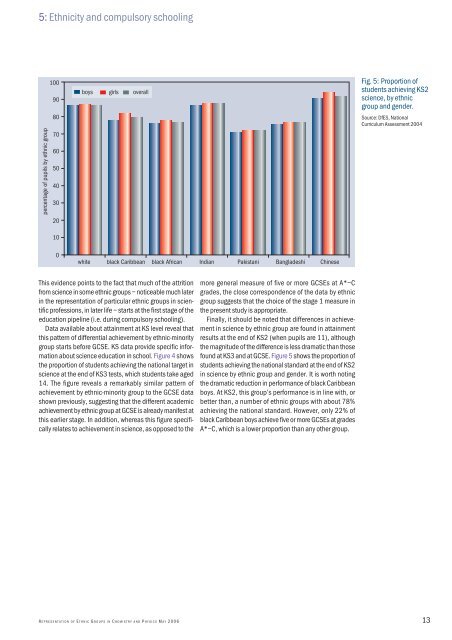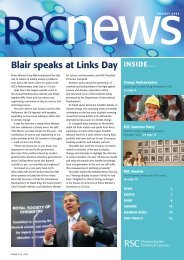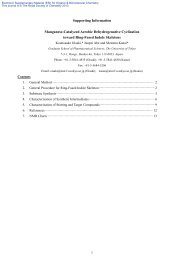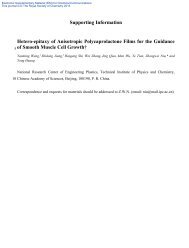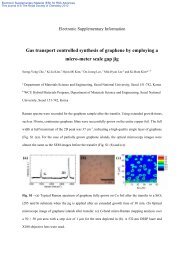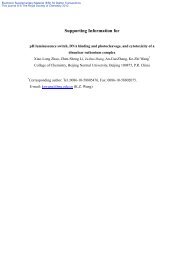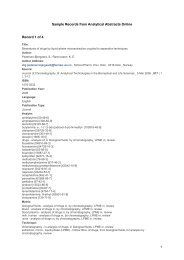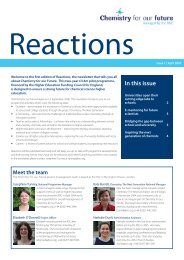Representation of Ethnic Groups in Chemistry and Physics
Representation of Ethnic Groups in Chemistry and Physics
Representation of Ethnic Groups in Chemistry and Physics
Create successful ePaper yourself
Turn your PDF publications into a flip-book with our unique Google optimized e-Paper software.
5: <strong>Ethnic</strong>ity <strong>and</strong> compulsory school<strong>in</strong>g<br />
percentage <strong>of</strong> pupils by ethnic group<br />
100<br />
90<br />
80<br />
70<br />
60<br />
50<br />
40<br />
30<br />
20<br />
10<br />
boys girls overall<br />
Fig. 5: Proportion <strong>of</strong><br />
students achiev<strong>in</strong>g KS2<br />
science, by ethnic<br />
group <strong>and</strong> gender.<br />
Source: DfES, National<br />
Curriculum Assessment 2004<br />
0<br />
white black Caribbean black African Indian Pakistani Bangladeshi Ch<strong>in</strong>ese<br />
This evidence po<strong>in</strong>ts to the fact that much <strong>of</strong> the attrition<br />
from science <strong>in</strong> some ethnic groups – noticeable much later<br />
<strong>in</strong> the representation <strong>of</strong> particular ethnic groups <strong>in</strong> scientific<br />
pr<strong>of</strong>essions, <strong>in</strong> later life – starts at the first stage <strong>of</strong> the<br />
education pipel<strong>in</strong>e (i.e. dur<strong>in</strong>g compulsory school<strong>in</strong>g).<br />
Data available about atta<strong>in</strong>ment at KS level reveal that<br />
this pattern <strong>of</strong> differential achievement by ethnic-m<strong>in</strong>ority<br />
group starts before GCSE. KS data provide specific <strong>in</strong>formation<br />
about science education <strong>in</strong> school. Figure 4 shows<br />
the proportion <strong>of</strong> students achiev<strong>in</strong>g the national target <strong>in</strong><br />
science at the end <strong>of</strong> KS3 tests, which students take aged<br />
14. The figure reveals a remarkably similar pattern <strong>of</strong><br />
achievement by ethnic-m<strong>in</strong>ority group to the GCSE data<br />
shown previously, suggest<strong>in</strong>g that the different academic<br />
achievement by ethnic group at GCSE is already manifest at<br />
this earlier stage. In addition, whereas this figure specifically<br />
relates to achievement <strong>in</strong> science, as opposed to the<br />
more general measure <strong>of</strong> five or more GCSEs at A*–C<br />
grades, the close correspondence <strong>of</strong> the data by ethnic<br />
group suggests that the choice <strong>of</strong> the stage 1 measure <strong>in</strong><br />
the present study is appropriate.<br />
F<strong>in</strong>ally, it should be noted that differences <strong>in</strong> achievement<br />
<strong>in</strong> science by ethnic group are found <strong>in</strong> atta<strong>in</strong>ment<br />
results at the end <strong>of</strong> KS2 (when pupils are 11), although<br />
the magnitude <strong>of</strong> the difference is less dramatic than those<br />
found at KS3 <strong>and</strong> at GCSE. Figure 5 shows the proportion <strong>of</strong><br />
students achiev<strong>in</strong>g the national st<strong>and</strong>ard at the end <strong>of</strong> KS2<br />
<strong>in</strong> science by ethnic group <strong>and</strong> gender. It is worth not<strong>in</strong>g<br />
the dramatic reduction <strong>in</strong> performance <strong>of</strong> black Caribbean<br />
boys. At KS2, this group’s performance is <strong>in</strong> l<strong>in</strong>e with, or<br />
better than, a number <strong>of</strong> ethnic groups with about 78%<br />
achiev<strong>in</strong>g the national st<strong>and</strong>ard. However, only 22% <strong>of</strong><br />
black Caribbean boys achieve five or more GCSEs at grades<br />
A*–C, which is a lower proportion than any other group.<br />
R EPRESENTATION OF E THNIC G ROUPS IN C HEMISTRY AND P HYSICS M AY 2006<br />
13


